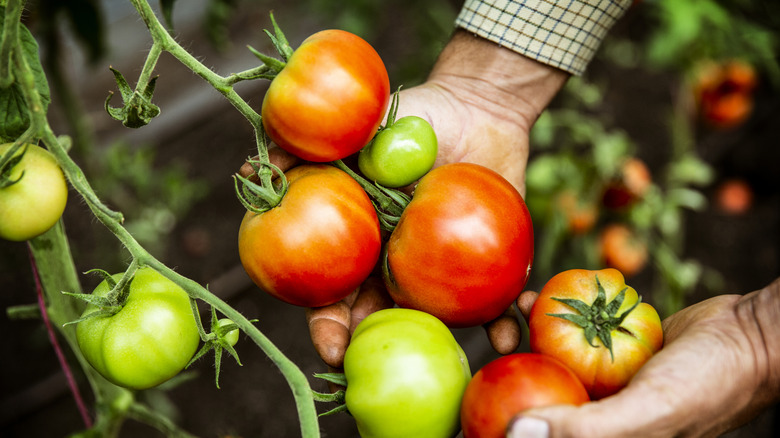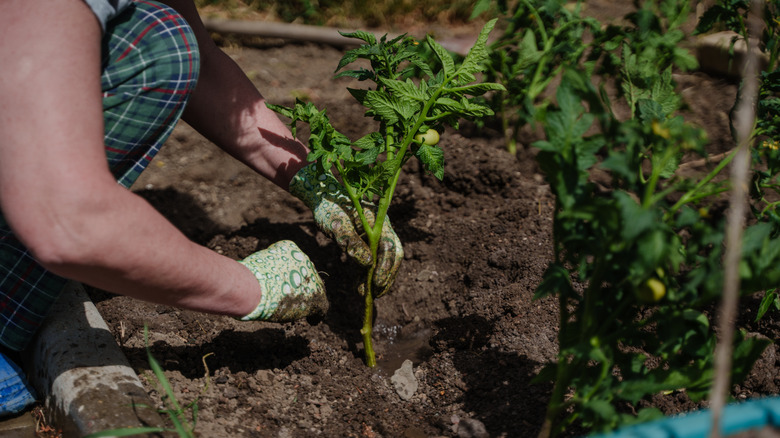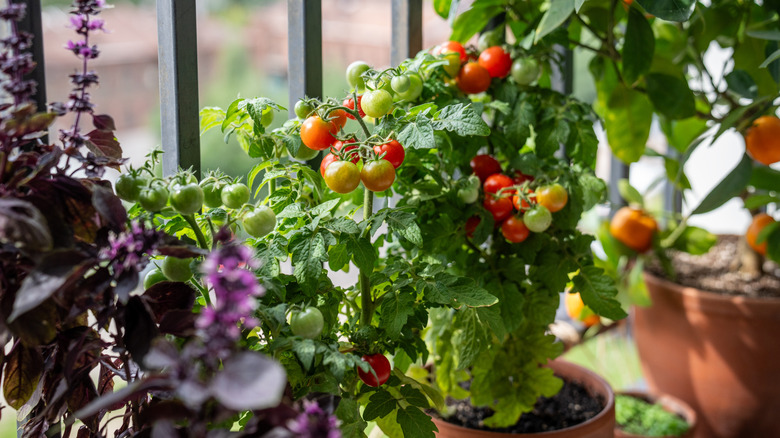How To Prep Your Tomato Plants For Winter To Keep Them Happy And Productive
Homegrown tomatoes (Solanum lycopersicum) are a delicious reward for the relatively small amount of time and care it takes to nurture them. Their flavor and freshness are unmatched compared to store-bought ones. In addition to the flavor, there is something deeply satisfying about picking a ripe tomato straight from the vine, knowing exactly how it was grown. Tomatoes are a crop that thrives in the warmer months, which typically means that having fresh-off-the-vine tomatoes for your salad or pasta dishes is out of the question once fall and winter roll around — or is it? Surprisingly, there is a way to prepare your tomato plants for fruit production throughout the winter. Overwintering your tomato plants takes planning and preparation, but it can help you enjoy fresh tomatoes year-round. Overwintering involves digging up your tomato plants, repotting them, and taking them indoors, where you will provide them with the right environment to support their growth.
If you're worried that preparing tomato plants for indoor growth will be difficult, don't be. It's possible to grow tomatoes indoors with very little preparation. The process of bringing your tomato plants inside for the colder months starts well before it's time to dig them up and repot them. It's good to go into this project well-informed, though, as this will ensure your tomato plants have the best chance of surviving indoors.
How to get your tomato plants ready and prepare their indoor space
Getting your tomato plants ready to bring inside starts a few weeks before you bring them in by ensuring they are getting plenty of water. Watering them well, both before and after potting them, will help prevent shock. It's also a good idea to check and treat, if necessary, any common garden tomato pests. These include caterpillars, aphids, and white flies. When you are ready to pot your plants, cut them down to about one to two feet and prune any dead leaves, fruit, and flowers. Then, carefully dig around the plant and pull up as much of the root system as possible, and place the plants in potting soil-filled containers.
Leave them outside in their pots for about a week and a half before bringing them inside to ensure they have acclimated to the container. During the outdoor waiting period, bring them indoors for a few hours each day, gradually increasing the time until about the 10-day mark, when they are ready to be taken inside permanently. If you want to avoid having to dig your tomato plants up for repotting, you can take cuttings from your mature plants and place them in water to grow roots in a sunny area of your home. Then, put them into pots.
Tips for thriving indoor tomato plants
If you have decided that overwintering your tomato plants is something you're interested in doing, there are a few tips and tricks that will help your success along. Unless you have a massive sunroom to dedicate to indoor winter gardening, you'll want to choose a compact tomato plant variety, such as one that grows in a bush form. When planning your summer garden, it's a great idea to take overwintering into account by planting at least a couple of these smaller tomato plant varieties.
Another tip for successful indoor tomato growth is choosing appropriately sized pots. Small tomato plant varieties do best in five-gallon containers, whereas larger plants may need up to 15 gallons. Tomato plants require ample space to promote healthy roots and retain moisture. Since healthy roots lead to a more abundant tomato harvest, you don't want to skimp on the size when choosing a growing container.
Another trick to making sure you get the best indoor tomato crop possible is ensuring your plants are placed where there is adequate light, temperature, and humidity. Tomato plants need from 12 to 16 hours of indirect sunlight each day. If you don't have a room with adequate natural light, LED grow lights can be used. As far as temperature and humidity go, the room where your plants are should be kept between 60 to 70 degrees Fahrenheit, with humidity maintained through misting or placing standing water nearby.


